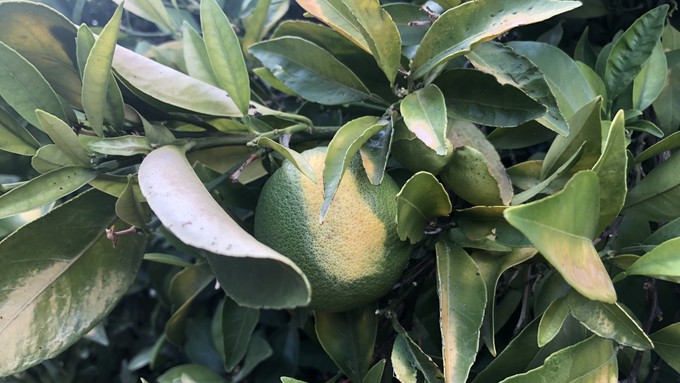
Delta breeze brings some relief after epic heat wave

Gardeners probably all feel like this poor navel orange, after more than a week of 100-degree-plus temperatures: Scorched. Kathy Morrison
Relief! The Delta Breeze never felt so good!
Onshore flow of cooler air has finally brought an end to the worse early September heat wave in Sacramento history.
How hot was it? According to the National Weather Service, Downtown Sacramento averaged 108.8 degrees over September’s first nine days, topping the old record for that period (101.1, set in 1923) by 7.7 degrees. Normal for the first two weeks of September: 92.6.
Our overnight lows set a record high, too, averaging 71.1 degrees over the first nine nights in September. This month often is pretty warm at night; the old high-low record was 69.7, set in 1998. Average for this time period: 60. 8.
“It was quite the start to September for #NorCal with a historic heat wave,” tweeted the Sacramento NWS office. “This helped bring the hottest start to the month of September on record for interior Northern California with the average high so far for Sacramento at 108.8 and 109.8 for Redding.”
Sacramento International Airport set daily records with new highs on six consecutive days, Sept. 4-9.
What a difference a little ocean breeze makes! The weather service predicts high temperatures 20 degrees or more cooler than last week. The forecast high for Wednesday: 81 degrees.
Sacramento is expected to stay comfortably in the 80s through next weekend. Instead of heat, the challenge now will be smoke from nearby wildfires. But forecasters anticipate the onshore flow will push most of the haze east, out of Sacramento.
What to do now that you can venture outdoors?
* Start by rinsing off your plants. Sticky residue from smoke can stick to leaves and clog pores, inhibiting their ability to “breathe.” This also will help get rid of spider mites, which have been loving this dry heat.
* Now is the time to plant for fall. Warm soil will get these veggies off to a fast start.
* Keep harvesting tomatoes, peppers, squash, melons and eggplant – if you have any. Wash veggies well to remove smoke residue.
* Compost annuals and vegetable crops that have finished producing.
* Cultivate and add compost to the soil to replenish its nutrients for fall and winter vegetables and flowers.
* Fertilize deciduous fruit trees.
* Plant onions, lettuce, peas, radishes, turnips, beets, carrots, bok choy, spinach and potatoes directly into the vegetable beds.
* Transplant cabbage, broccoli, kale, Brussels sprouts and cauliflower as well as lettuce seedlings.
* Sow seeds of California poppies, clarkia and African daisies. Transplant cool-weather annuals such as pansies, violas, fairy primroses, calendulas, stocks and snapdragons.
* Divide and replant bulbs, rhizomes and perennials.
* Dig up and divide daylilies as they complete their bloom cycle.
Comments
0 comments have been posted.Sacramento Digs Gardening to your inbox.
Food in My Back Yard Series
May 6: Maintain soil moisture with mulch for garden success
April 29: What's (already) wrong with my tomato plants?
April 22: Should you stock up on fertilizer? (Yes!)
April 15: Grow culinary herbs in containers
April 8: When to plant summer vegetables
April 1: Don't be fooled by these garden myths
March 25: Fertilizer tips: How to 'feed' your vegetables for healthy growth
March 18: Time to give vegetable seedlings some more space
March 11: Ways to win the fight against weeds
March 4: Potatoes from the garden
Feb. 25: Plant a fruit tree now -- for later
Feb. 18: How to squeeze more food into less space
Feb. 11: When to plant? Consider staggering your transplants
Feb. 4: Starting in seed starting
Sites We Like
Garden Checklist for week of May 11
Make the most of the lower temperatures early in the week. We’ll be back in the 80s by Thursday.
* Plant, plant, plant! It’s prime planting season in the Sacramento area. Time to set out those tomato transplants along with peppers and eggplants. Pinch off any flowers on new transplants to make them concentrate on establishing roots instead of setting premature fruit.
* Direct-seed melons, cucumbers, summer squash, corn, radishes, pumpkins and annual herbs such as basil.
* Harvest cabbage, lettuce, peas and green onions.
* In the flower garden, direct-seed sunflowers, cosmos, salvia, zinnias, marigolds, celosia and asters. (You also can transplant seedlings for many of the same flowers.)
* Plant dahlia tubers.
* Transplant petunias, marigolds and perennial flowers such as astilbe, columbine, coneflowers, coreopsis, dahlias, rudbeckia and verbena.
* Keep an eye out for slugs, snails, earwigs and aphids that want to dine on tender new growth.
* Feed summer bloomers with a balanced fertilizer.
* For continued bloom, cut off spent flowers on roses as well as other flowering plants.
* Add mulch to the garden to maintain moisture. Mulch also cuts down on weeds. But don’t let it mound around the stems or trunks of trees or shrubs. Leave about a 6-inch-to-1-foot circle to avoid crown rot or other problems.
* Remember to weed! Pull those nasties before they set seed.
* Water early in the day and keep seedlings evenly moist.